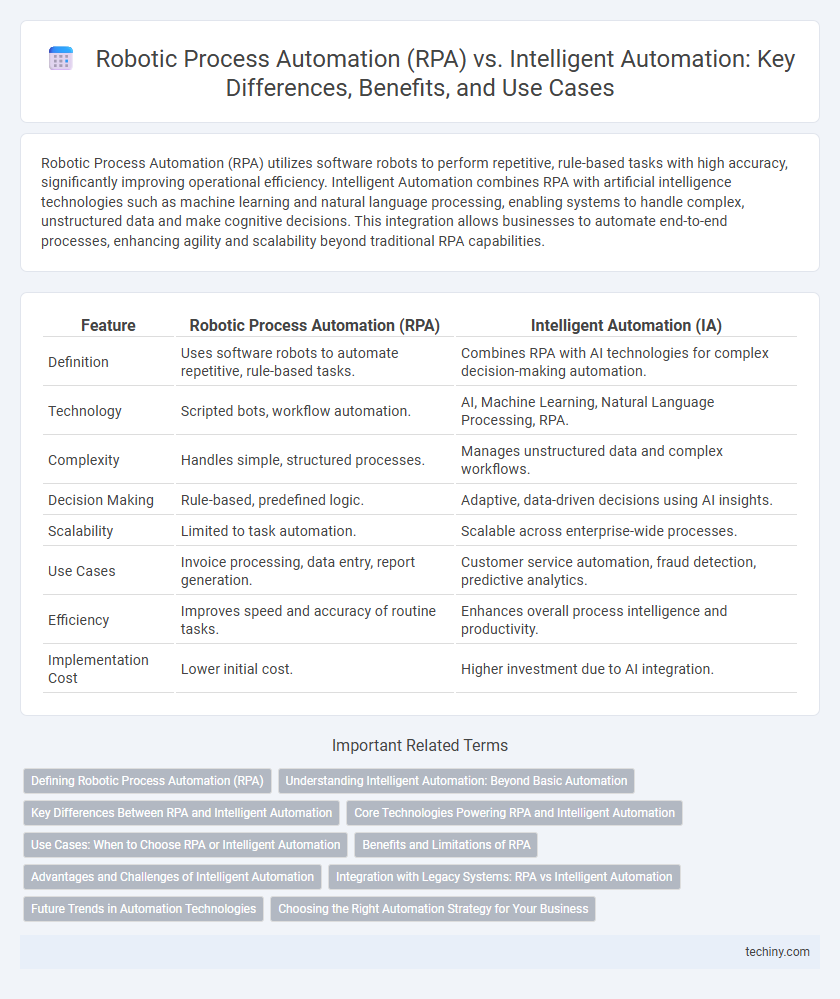Robotic Process Automation (RPA) utilizes software robots to perform repetitive, rule-based tasks with high accuracy, significantly improving operational efficiency. Intelligent Automation combines RPA with artificial intelligence technologies such as machine learning and natural language processing, enabling systems to handle complex, unstructured data and make cognitive decisions. This integration allows businesses to automate end-to-end processes, enhancing agility and scalability beyond traditional RPA capabilities.
Table of Comparison
| Feature | Robotic Process Automation (RPA) | Intelligent Automation (IA) |
|---|---|---|
| Definition | Uses software robots to automate repetitive, rule-based tasks. | Combines RPA with AI technologies for complex decision-making automation. |
| Technology | Scripted bots, workflow automation. | AI, Machine Learning, Natural Language Processing, RPA. |
| Complexity | Handles simple, structured processes. | Manages unstructured data and complex workflows. |
| Decision Making | Rule-based, predefined logic. | Adaptive, data-driven decisions using AI insights. |
| Scalability | Limited to task automation. | Scalable across enterprise-wide processes. |
| Use Cases | Invoice processing, data entry, report generation. | Customer service automation, fraud detection, predictive analytics. |
| Efficiency | Improves speed and accuracy of routine tasks. | Enhances overall process intelligence and productivity. |
| Implementation Cost | Lower initial cost. | Higher investment due to AI integration. |
Defining Robotic Process Automation (RPA)
Robotic Process Automation (RPA) refers to software robots that mimic repetitive, rule-based tasks within business processes to increase efficiency and reduce human error. Unlike Intelligent Automation, which combines AI and machine learning to handle complex decision-making, RPA operates based on predefined scripts without cognitive abilities. RPA is widely used in finance, customer service, and supply chain management to automate high-volume, structured workflows.
Understanding Intelligent Automation: Beyond Basic Automation
Intelligent Automation (IA) extends Robotic Process Automation (RPA) by integrating artificial intelligence technologies such as machine learning, natural language processing, and computer vision to handle complex, unstructured data and decision-making tasks. Unlike RPA, which automates repetitive, rule-based processes, IA enables dynamic adaptation to changing environments and continuous learning, enhancing workflow efficiency and accuracy. Enterprises leveraging Intelligent Automation achieve higher operational agility and scalability through intelligent process orchestration and cognitive insights.
Key Differences Between RPA and Intelligent Automation
Robotic Process Automation (RPA) automates repetitive, rule-based tasks through software robots, enhancing efficiency in structured processes. Intelligent Automation integrates artificial intelligence technologies such as machine learning, natural language processing, and cognitive capabilities to handle unstructured data and make decisions. The key difference lies in RPA's reliance on predefined rules versus Intelligent Automation's ability to learn, adapt, and improve processes autonomously.
Core Technologies Powering RPA and Intelligent Automation
Robotic Process Automation (RPA) leverages rule-based software bots and scripting technologies to automate repetitive, structured tasks, primarily using screen scraping and workflow automation tools. Intelligent Automation integrates RPA with advanced core technologies such as artificial intelligence (AI), machine learning (ML), natural language processing (NLP), and computer vision to handle unstructured data and enable cognitive decision-making processes. These foundational technologies allow Intelligent Automation to adapt, learn, and improve over time, surpassing the static and predefined capabilities of traditional RPA systems.
Use Cases: When to Choose RPA or Intelligent Automation
Robotic Process Automation (RPA) is ideal for rule-based, repetitive tasks such as data entry, invoice processing, and employee onboarding, delivering quick efficiency gains without complex system integrations. Intelligent Automation combines RPA with AI technologies like machine learning and natural language processing, enabling automation of cognitive tasks such as customer service chatbots, fraud detection, and predictive analytics. Organizations should choose RPA when automating structured, high-volume processes, while Intelligent Automation suits scenarios requiring adaptability, unstructured data handling, and decision-making capabilities.
Benefits and Limitations of RPA
Robotic Process Automation (RPA) accelerates repetitive task completion by mimicking human actions, significantly reducing operational costs and minimizing errors in data entry and processing. However, RPA's limitations include its inability to adapt to complex decision-making or unstructured data without extensive programming, restricting its use to rule-based processes. Unlike Intelligent Automation, which integrates artificial intelligence and machine learning for dynamic problem-solving, RPA alone lacks cognitive capabilities and scalability in evolving business environments.
Advantages and Challenges of Intelligent Automation
Intelligent Automation combines Robotic Process Automation (RPA) with Artificial Intelligence (AI) technologies like machine learning and natural language processing to handle complex, unstructured data tasks, offering superior scalability and adaptability compared to traditional RPA. Key advantages include enhanced decision-making capabilities, reduced human error, and improved operational efficiency across dynamic environments. Challenges involve high implementation costs, the need for continuous AI model training, and overcoming integration complexities with legacy systems.
Integration with Legacy Systems: RPA vs Intelligent Automation
Robotic Process Automation (RPA) excels at integrating with legacy systems by mimicking user interactions without requiring system modifications, enabling quick deployment and minimal disruption. Intelligent Automation goes beyond by combining RPA with artificial intelligence and machine learning, allowing deeper integration through data interpretation and adaptive workflows that handle unstructured data and complex processes. While RPA is effective for rule-based tasks, Intelligent Automation offers greater scalability and flexibility for evolving legacy environments.
Future Trends in Automation Technologies
Robotic Process Automation (RPA) is evolving beyond rule-based task automation to Intelligent Automation, which integrates artificial intelligence, machine learning, and natural language processing for enhanced decision-making and adaptability. Future trends indicate a shift towards hyperautomation, combining RPA with AI-driven analytics, cognitive automation, and real-time data processing to optimize complex business processes. Enterprises investing in Intelligent Automation can expect increased operational efficiency, reduced human error, and scalable automation solutions that continuously learn and improve.
Choosing the Right Automation Strategy for Your Business
Robotic Process Automation (RPA) excels in automating repetitive, rule-based tasks, offering quick implementation and cost savings for processes with structured data. Intelligent Automation combines RPA with artificial intelligence technologies like machine learning and natural language processing, enabling the automation of complex, unstructured workflows and decision-making. Selecting the right automation strategy depends on assessing business needs, process complexity, and scalability requirements to maximize efficiency and ROI.
Robotic Process Automation (RPA) vs Intelligent Automation Infographic

 techiny.com
techiny.com